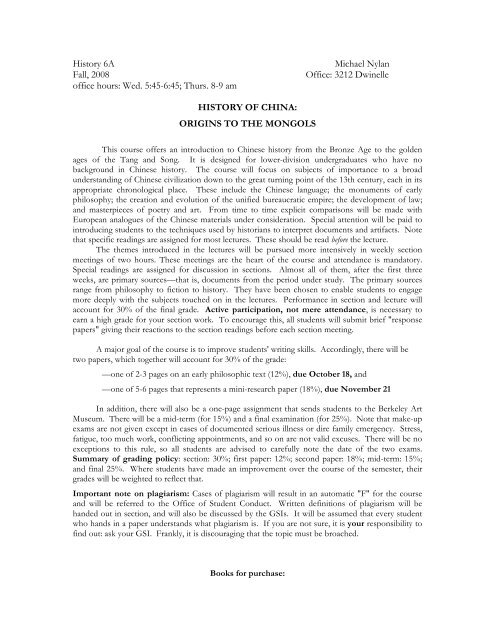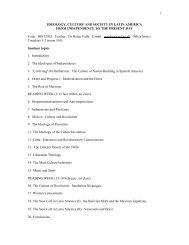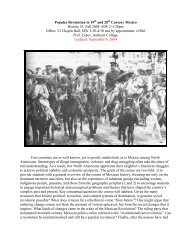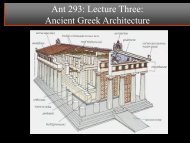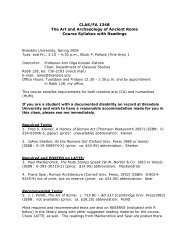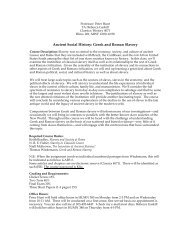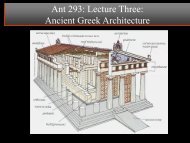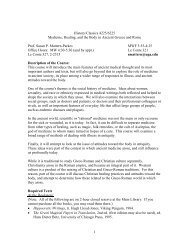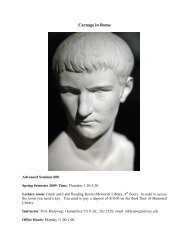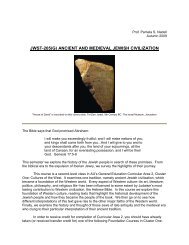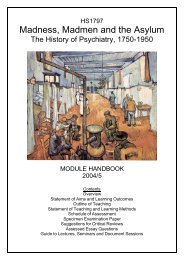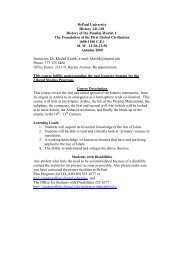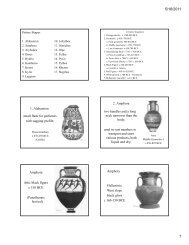History Of China
History Of China
History Of China
You also want an ePaper? Increase the reach of your titles
YUMPU automatically turns print PDFs into web optimized ePapers that Google loves.
<strong>History</strong> 6AFall, 2008office hours: Wed. 5:45-6:45; Thurs. 8-9 amMichael Nylan<strong>Of</strong>fice: 3212 DwinelleHISTORY OF CHINA:ORIGINS TO THE MONGOLSThis course offers an introduction to Chinese history from the Bronze Age to the goldenages of the Tang and Song. It is designed for lower-division undergraduates who have nobackground in Chinese history. The course will focus on subjects of importance to a broadunderstanding of Chinese civilization down to the great turning point of the 13th century, each in itsappropriate chronological place. These include the Chinese language; the monuments of earlyphilosophy; the creation and evolution of the unified bureaucratic empire; the development of law;and masterpieces of poetry and art. From time to time explicit comparisons will be made withEuropean analogues of the Chinese materials under consideration. Special attention will be paid tointroducing students to the techniques used by historians to interpret documents and artifacts. Notethat specific readings are assigned for most lectures. These should be read before the lecture.The themes introduced in the lectures will be pursued more intensively in weekly sectionmeetings of two hours. These meetings are the heart of the course and attendance is mandatory.Special readings are assigned for discussion in sections. Almost all of them, after the first threeweeks, are primary sources—that is, documents from the period under study. The primary sourcesrange from philosophy to fiction to history. They have been chosen to enable students to engagemore deeply with the subjects touched on in the lectures. Performance in section and lecture willaccount for 30% of the final grade. Active participation, not mere attendance, is necessary toearn a high grade for your section work. To encourage this, all students will submit brief "responsepapers" giving their reactions to the section readings before each section meeting.A major goal of the course is to improve students' writing skills. Accordingly, there will betwo papers, which together will account for 30% of the grade:—one of 2-3 pages on an early philosophic text (12%), due October 18, and—one of 5-6 pages that represents a mini-research paper (18%), due November 21In addition, there will also be a one-page assignment that sends students to the Berkeley ArtMuseum. There will be a mid-term (for 15%) and a final examination (for 25%). Note that make-upexams are not given except in cases of documented serious illness or dire family emergency. Stress,fatigue, too much work, conflicting appointments, and so on are not valid excuses. There will be noexceptions to this rule, so all students are advised to carefully note the date of the two exams.Summary of grading policy: section: 30%; first paper: 12%; second paper: 18%; mid-term: 15%;and final 25%. Where students have made an improvement over the course of the semester, theirgrades will be weighted to reflect that.Important note on plagiarism: Cases of plagiarism will result in an automatic "F" for the courseand will be referred to the <strong>Of</strong>fice of Student Conduct. Written definitions of plagiarism will behanded out in section, and will also be discussed by the GSIs. It will be assumed that every studentwho hands in a paper understands what plagiarism is. If you are not sure, it is your responsibility tofind out: ask your GSI. Frankly, it is discouraging that the topic must be broached.Books for purchase:
2Note that most of the required texts are available for half-price on the Web, including Ebrey's Illustrated<strong>History</strong>. It is not true, however, of the <strong>History</strong> 6A Reader. Most students will want to purchase the reader,as all readings for the course will be in that Reader, except for assignments in the books marked below as 'forpurchase.' The Reader will be available at Metro Publishing, 2440 Bancroft Avenue. One copy will also beplaced on Moffitt Reserve as soon as possible.Charles Benn, <strong>China</strong>'s Golden Age (Oxford, 2002).Mark Csikszentmihalyi, Readings in Han Chinese Thought (Hackett, 2006).Corinne Debaine-Francfort, The Search for Ancient <strong>China</strong> (Abrams, 1999).Patricia Ebrey, The Cambridge Illustrated <strong>History</strong> of <strong>China</strong> (Cambridge, 1996). All references to "Ebrey" are to thisedition unless noted (ISBN 052166991x).Simon Leys, The Analects of Confucius (Norton, 1997).Basic Writings: Chuang tzu; Basic Writings (Columbia, 2003), Burton Watson, trans. Newer but not revised editionsare Zhuangzi: Basic Writings (ISBN:0231129599), with slightly different pagination.Recommended books for those of you who get hooked on Chinese history (in order of importance):Jacques Gernet, A <strong>History</strong> of Chinese Civilization (Cambridge University Press, 1991). [Some of you may wish tobuy this book instead of the Ebrey, once you decide you are fully committed to Chinese history. Thisbook, available in a paperback edition, remains the standard reference work for the field. Copies willbe put on reserve in Moffitt.]Kristofer Schipper, The Taoist Body (U-C Press, 1993), recommended paperback; available at half-price fromthe Web.Craig Clunas, Art in <strong>China</strong> (Oxford U. 1997).Wm. Theodore de Bary and Irene Bloom, eds., Sources of Chinese Tradition, Second Edition, Volume 1 (Columbia U.Press, 1999). This edition is substantially revised and improved over the first edition. If you are buyingor consulting this, do not confuse the two.and lastly for help in writing better papers: the Penguin illustrated edition of Elements of Style, the classichandbook by Strunk and White (available in local bookstores, under "recommended" for <strong>History</strong> 6A).S Y L L A B U SWeek 18/27 Introduction to the course. Why bother with history? Why bother with <strong>China</strong>?Week 29/1 holiday; no class.9/3 geography, climate, and populationWeek 3Lecture readings for 9/1 (in <strong>History</strong> 6A Reader): Mark Elvin, The Retreat of the Elephants,pp. 3-39.Sections will meet to discuss issues in Chinese language, based on Lothar Ledderose,Ten Thousand Things, "The System of Script," pp. 9-10, 18-23. No reading required.9/8 Chinese language, spoken and writtenLecture readings for 9/6: John DeFrancis, The Chinese Language: Fact and Fantasy, pp. 1-57;Cecilia Lindqvist, Empire of Living Symbols, pp. 16-35; A. Zee, Swallowing Clouds, pp. 47-52.
5Axes," in Chenyang Li, ed., The Sage and the Second Sex, pp. 199-222 (class Website). movie:Emperor and the Assassin.Section readings: Sima Qian, Records of the Grand Historian, "Bo Yi and Shu Qi": chapter onthe moneymakers (SJ 129); Jia Yi's "Guo Qin lun" (On the Faults of the Qin).Week 910/20 Han empire and its attempt to devise coherent systemsLecture readings (10/20): Michael Nylan, The Five "Confucian" Classics, pp. 1-41 (to "7") 51-61; 363-71; DeBaine-Francfort, pp. 100-27; Tao Qian, "Peach Blossom Spring."10/22 Three Kingdoms: social, religious and political developments, 3rd-7th centuries.Lecture readings (10/22): Ebrey, pp. 86-107; Etienne Balazs, "Evolution ofLandownership in Fourth and Fifth-Century <strong>China</strong>," "Nihilistic Revolt or MysticalEscapism," in Chinese Civilization and Bureaucracy, pp. 101-112, 226-254; Wolfram Eberhard, A<strong>History</strong> of <strong>China</strong> (rev.), pp. 95-102; 109-34, 138-147. also recommended: Rafe de Crespigny,"The Three Kingdoms and Western Jin: a <strong>History</strong> of <strong>China</strong> in the Third Century AD" (seeauthor's Website at Australian National University); de Crespigny: To Establish Peace, pp. 303-461 (covering years 201-215, with all the cast of characters from the Three Kingdomsmaking their appearances there).Sections: required trip to Moffit library to begin work on research papers.Participation is vital, because it will facilitate thinking about good paper topics and theproper evaluation of sources. By 10/18, at 5 p.m., the small paper is due, and the topic forpaper 2 should be decided by 10/29, in consultation with Nylan or section leaders.Everybody must sign up for 10 minute sessions with one of these four teachers. For helpin preparation with that paper, please see http://ccat.sas.upenn.edu/~nsivin, whichincludes a useful reference to a Guide to Writing.Week 1010/27 DaoismLecture readings (10/20): Kristofer Schipper, The Taoist Body, pp. 1-15, 20-108. (Thisreading is far less daunting than it looks; the text is written for novices.) Please read also theHawaii Reader in Traditional Chinese Culture, ed. Victor H. Mair, et al., nos. 33, 37 (pp. 225-30;242-250).10/29 BuddhismLecture readings (10/20): Arthur Wright, Buddhism in Chinese <strong>History</strong>, pp. 1-64; JohnKieschnick, The Impact of Buddhism on Chinese Material Culture, pp. 1-48; 281-94 (this to beskimmed); Albert Welter, “Buddhist Ritual and the State,” in Donald Lopez, Religions of <strong>China</strong>in Practice, pp. 390-396.Section readings: Mark Csikszentmihalyi, Readings in Han Chinese Thought, pp. 116-183.Week 1111/3 Sui and Tang
6Lecture readings (10/26): Ebrey, pp. 108-35; Arthur Wright, Buddhism in Chinese <strong>History</strong>,pp. 65-107; Benn, <strong>China</strong>'s Golden Age, chaps. 1-4, 7-9; Craig Clunas, Art in <strong>China</strong>, "EarlyBuddhist Art" (pp. 89-113).11/5 Tang poetryLecture readings (10/28): Stephen Owen, "Poetry in the Chinese Tradition," in Paul Ropp,ed., Heritage of <strong>China</strong>, pp. 294-308; in class, we'll also take a look at Tony and WillisBarnstone, Laughing Lost in the Mountains: the poems of Wang Wei (see Website).Section readings: Han Yu, "Memorial on the Bone of the Buddha"; Emperor Wuzong,"Edict on the Suppression of Buddhism"; "The Story of How the Monk Tripitaka of theGreat Country of T’ang Brought back the Sûtras," a 13th-century version of Journey to theWest, in Victor Mair, The Columbia Anthology of Traditional Chinese Literature, pp. 1181-1207;Hawaii Reader in Traditional Chinese Culture, ed. Victor H. Mair, et al., nos. 47, 56, 63 (pp. 295-299; 377-379, 423-25).Week 1211/10 Demographic and economic revolutions in Tang and SongLecture readings (11/10): F. W. Mote, Imperial <strong>China</strong>, 900-1800, pp. 351-54; Mark Elvin,The Pattern of the Chinese Past, "The Revolution in Farming" and "The Revolution in Moneyand Credit" (pp. 113-30, 146-63).11/12 The emergence of a new elite, printing in Tang and SongLecture readings (11/12): Susan Cherniack, "Book Culture and Textual Transmission inSung <strong>China</strong>," Harvard Journal of Asiatic Studies 54:1 (June, 1994), 5-57 (JSTOR). Do NOTfinish the article; it's too technical; ignore the half of the pages that are footnotes.Section readings: James T. C. Liu, trans, The Enlightened Judgements, pp. 61-87 (from "Article3"); 278-293; Bo Juyi, "Song of Lasting Pain" and Du Fu, "The Formation of a Soldier/Outto the Frontier"; plus "The Ornaments of Literati Culture," in Stephen Owen, An Anthologyof Chinese Literature, pp. 442-47; 472-75; 637-652; 663-82.Week 1311/17 Song painting and calligraphyLecture readings (11/17): Ebrey, pp. 136-50 (to "Turn Inward"); Craig Clunas,Art in <strong>China</strong>, pp. 45-63, 135-53, 173-75.11/19 Song collecting practicesLecture readings (11/19): Ebrey, pp. 150-63; Ronald Egan, on Li Qingzhao (on Website)Stephen Owen, "The Snares of Memory," Remembrances: The Experience of the Past in ChineseClassical Literature, pp. 80-99. No sections this week. Research paper due Nov. 21.Sections will visit the Berkeley Art Museum.Week 1411/24 Northern Song crisisLecture readings (11/24): review Ebrey, pp. 136-163; James Liu, Reform in Sung <strong>China</strong>, pp. 1-58.
711/26 NO CLASS THANKSGIVING BREAK.Week 15:12/1 Nylan away to give a lecture at Harvard. NO CLASS.12/3 Song technology and scienceLecture readings (12/3): Mark Elvin, The Pattern of the Chinese Past, pp. 179-99; Hilde DeWeerdt, Competition over Content, on the civil service exams, pp. 1-22; 25-34 pp. 42-54 (from"Discursive Practices" to "The genealogy of the Four Masters"); Nathan Sivin, "Shen Kua,"Science in Ancient <strong>China</strong>, II, pp. 1-52 (on reserve).Section readings: Cheng Hao, "Remonstrance against the New Laws" to Zhu Xi, "WangAnshi in Retrospect," in de Bary, Sources, vol. 1, 618-28; Zhu Xi, "How to read a book," inNeo-Confucian Education," in de Bary, pp. 800-14; Madam Cheng, "Classic of Filiality forWomen," in ibid., pp. 824-31; Zhang Jiucheng's explanation of Zhang Zai's "WesternInscription."Last week12/8 Southern Song: Military catastrophe; a new ideology. last class; sections begin reviewLecture readings (12/2): review Ebrey, pp. 136-163; Ebrey, pp. 164-85; Mote, Imperial <strong>China</strong>, pp.289-98, 323-50 (you should skip the short section "Zhao Mingcheng and Li Qingzhao").12/10 In-class FINAL


